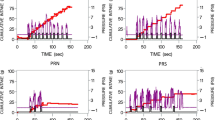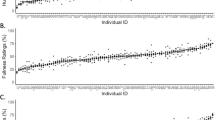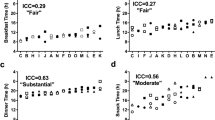Abstract
Early attempts at the objective measurement of food intake in humans followed many heuristic pioneer studies in laboratory animals, which revealed how homeostatic and hedonic factors interact to shape the daily eating patterns. Early studies in humans examined the characteristics of intake responses at discrete ingestive events. Described for the first time in 1969, the edogram consisted of a parallel recording of chewing and swallowing responses during standardized lunches, allowing parameters of the “microstructure of meals” to be quantified under varying conditions of deprivation or sensory stimulation, in parallel with overall meal size, meal duration, and eating rate. Edographic studies showed consistent changes in the microstructure of meals in response to palatability level (increased eating rate, decreased chewing time and number of chews per food unit, shorter intrameal pauses, and increased prandial drinking under improved palatability). Longer premeal deprivation affected the eating responses at the beginning of meals (decreased chewing time and number of chews per food unit) but not at the end. Eating rate decelerated during the course of meals in normal-weight participants but not in participants with obesity. These observations largely agreed with contemporary works using other objective measurement methods. They were confirmed and expanded in later studies, notably in the investigation of satiation mechanisms affecting weight control. Importantly, research has demonstrated that the parameters of the microstructure of meals not only reflect the influence of stimulatory/inhibitory factors but can, per se, exert a causal role in satiation and satiety. The early edographic recording instruments were improved over the years and taken out of laboratory settings in order to address the measurement of spontaneous intake responses in free-living individuals. Much remains to be done to make these instruments entirely reliable under the immense variety of situations where food consumption occurs.
This is a preview of subscription content, access via your institution
Access options
Subscribe to this journal
Receive 12 print issues and online access
$259.00 per year
only $21.58 per issue
Buy this article
- Purchase on Springer Link
- Instant access to full article PDF
Prices may be subject to local taxes which are calculated during checkout

Similar content being viewed by others
Change history
30 August 2020
This article was amended to correct a typesetting error in Figure 1.
References
Bellisle F. Food intake and physiological regulation: the means and the end. In: Meiselman HL, editor. Handbook of eating and drinking. Springer Nature Switzerland AG; 2019. https://doi.org/10.1007/978-3-319-75388-1_128-1.
WHO. https://www.who.int/en/news-room/fact-sheets/detail/obesity-and-overweight.
Butland B, Jebb S, Kopelman P, McPherson K, Thomas S, Mardell J, et al. Foresight. Tackling obesities: future choices. Project report. London: Government Office for Science; 2007.
De Castro JM. The control of food intake of free-living humans: putting the pieces back together. Physiol Behav. 2010;100:446–53.
Ramsay DS, Woods SC. Physiological regulation: how it really works. Cell Metab. 2016;24:361–4.
Berthoud HR. 70th anniversary: body weight regulation—food, gut and brain signaling. Plenary lecture II. The neurobiology of food intake in an obesogenic environment. Proc Nutr Soc. 2012;71:478–87.
Blundell JE, Rogers PJ, Hill AJ. Evaluation of the satiating power of foods: implications for acceptance and consumption. In: Solms J, Booth DA, Pangbourne RM, Raunhardt O, editors. Food acceptance and nutrition. London: Academic Press; 1987. p. 205–19.
Blundell JE, de Graaf K, Hulshof T, Jebb S, Livingstone B, Lluch A, et al. Appetite control: methodological aspects of the evaluation of food. Obes Rev. 2010;11:251–70.
Kant AK, Graubard BI. Secular trends in patterns of self-reported food consumption of adult Americans: NHANES 1971–1975 to 1999–2002. Am J Clin Nutr. 2006;84:1215–23.
Herz M. Einige Bemerkungen über das saugen der Kinder. Jahrbuch Kinderh. 1865;7:46.
Kron RE, Stein M, Goddard KA. A method of measuring sucking behavior of newborn infants. Psychosom Med. 1963;25:181–91.
Hashim SA, Van Itallie TB. An automatically monitored food dispensing apparatus for the study of food intake in man. Fed Proc. 1964;23:82–4.
Hashim SA, Van Itallie TB. Studies in normal and obese subjects with a monitored food dispensing device. N Y Acad Sci. 1965;131:654–61.
Jordan HA, Wieland WF, Zebley SP, Stellar E, Stunkard AJ. Direct measurement of food intake in man: a method for the objective study of eating behavior. Psychosom Med. 1966;28:836–42.
Pudel V. Food-dispenser: eine methode zur untersuchung des spontanen appetitverhaltens. Zeitschrift fur Ernahrungswissenschaft. 1971;10:382–93.
Meyer JE, Pudel V. Experimental studies on food intake in obese and normal weight subjects. Psychosom Res. 1972;16:305–8.
Kissileff HR, Klingsberg G, Van Itallie TB. Universal eating monitor for continuous recording of solid or liquid consumption in man. Am J Physiol. 1980;238:R14–22.
Guss JL, Kissileff HR. Microstructural analysis of human ingestive patterns: from description to mechanistic hypotheses. Neurosci Biobehav Rev. 2000;24:261–8.
Pierson A, Le Magnen J. Quantitative study of the process of regulation of feeding responses in man. Physiol Behav. 1969;4:61–7.
Pierson A, Le Magnen J. Study of food textures by recording of chewing and swallowing movements. J Texture Stud. 1970;1:327–37.
Bellisle F, Le Magnen J. The analysis of human feeding patterns: the edogram. Appetite. 1980;1:141–50.
Bellisle F, Le Magnen J. The structure of meals in humans: eating and drinking patterns in lean and obese subjects. Physiol Behav. 1981;27:649–58.
Bellisle F, Lucas F, Amrani R, Le Magnen J. Deprivation, palatability and the micro-structure of meals in human subjects. Appetite. 1984;5:85–94.
De Castro JM. A microregulatory analysis of spontaneous fluid intake by humans: evidence that the amount of liquid ingested and its timing is mainly governed by feeding. Physiol Behav. 1988;43:705–14.
McKiernan F, Houchins JA, Mattes RD. Relationships between human thirst, hunger, drinking, and feeding. Physiol Behav. 2008;94:700–8.
Spiegel TA, Shrager EE, Stellar E. Responses of lean and obese subjects to preloads, deprivation, and palatability. Appetite. 1989;13:45–69.
Kissileff HR, Thornton J, Becker E. A quadratic equation describes the cumulative food intake curve in man. Appetite. 1982;3:255–72.
Bobroff EM, Kissileff HR. Effects of change in palatability on food intake and the cumulative food intake curve in man. Appetite. 1986;6:85–96.
Yeomans MR, Gray RW, Mitchell CJ, True S. Independent effects of palatability and within-meal pauses on intake and appetite ratings in human volunteers. Appetite. 1997;29:61–76.
Laessle RG, Lehrke SL, Dückers S. Laboratory eating behavior in obesity. Appetite. 2007;49:399–404.
de Wijk RA, Zijlstra N, Mars M, de Graaf C, Prinz JF. The effects of food viscosity on bite size, bite effort and food intake. Physiol Behav. 2008;95:527–32.
Bolhuis DP, Forde CG, Cheng Y, Hu H, Martin N, de Graaf C. Slow food: sustained impact of harder foods on the reduction of energy intake over the course of the day. PLoS ONE. 2014;9:e93370.
Bolhuis DP, Lakemond CM, de Wijk RA, Luning PA, de Graaf C. Both a higher number of sips and a longer oral transit time reduce ad libitum intake. Food Qual Prefer. 2014;32:234–40.
Forde CG, van Kuijk N, Thaler T, de Graaf C, Martin N. Oral processing characteristics of solid savoury meal components, and relationship with food composition, sensory attributes and expected satiation. Appetite. 2013;60:208–19.
Ioakimidis I, Zandian M, Eriksson-Marklund L, Bergh C, Grigoriadis A, Södersten P. Description of chewing and food intake over the course of a meal. Physiol Behav. 2011;104:761–9.
Robinson E, Almiron-Roig E, Rutters F, de Graaf C, Forde CG, Smith CT, et al. A systematic review and meta-analysis examining the effect of eating rate on energy intake and hunger. Am J Clin Nutr. 2014;100:123–51.
Yarmolinsky DA, Zuker CS, Ryba NJ. Common sense about taste: from mammals to insects. Cell. 2009;139:234–44.
Kokkinos A, le Roux CW, Alexiadou K, Tentolouris N, Vincent RP, Kyriaki D, et al. Eating slowly increases the postprandial response of the anorexigenic gut hormones, peptide YY and glucagon-like peptide-1. J Clin Endocrinol Metab. 2010;95:333–7.
Li J, Zhang N, Hu L, Li Z, Li R, Li C, et al. Improvement in chewing activity reduces energy intake in one meal and modulates plasma gut hormone concentrations in obese and lean young Chinese men. Am J Clin Nutr. 2011;94:709–16.
Rolls BJ, Rolls ET, Rowe EA. Sensory specific satiety in man. Psysiol Behav. 1981;27:137–42.
Hetherington M, Havermans RC. Sensory-specific satiation and satiey. In: Blundell JE, Bellisle F, editors. Satiation, satiety and the control of food intake. Oxford: Woodhead Publishing Ltd; 2013. p. 253–69.
Ferriday D, Bosworth ML, Lai S, Godinot N, Martin N, Martin AA, et al. Effects of eating rate on satiety: a role for episodic memory? Physiol Behav. 2015;152:389–96.
Zhu Y, Hollis JH. Increasing the number of chews before swallowing reduces meal size in normal-weight, overweight, and obese adults. J Acad Nutr Diet. 2014;114:926–31.
Smit HJ, Kemsley EK, Tapp HS, Henry CJK. Does prolonged chewing reduce food intake? Fletcherism revisited. Appetite. 2011;57:295–8.
Higgs S, Jones A. Prolonged chewing at lunch decreases later snack intake. Appetite. 2013;62:91–5.
Zandian M, Ioakimidis I, Bergh C, Brodin U, Södersten P. Decelerated and linear eaters: effect of eating rate of food intake and satiety. Physiol Behav. 2009;96:270–5.
Spiegel TA, Kaplan JM, Tomassini A, Stellar E. Bite size, ingestion rate, and meal size in lean and obese women. Appetite. 1993;21:131–45.
Zijlstra N, de Wijk RA, Mars M, Stafleu A, de Graaf C. Effect of bite size and oral processing time of a semisolid food on satiation. Am J Clin Nutr. 2009;90:269–75.
Krop EM, Hetherington MM, Nekitsing C, Miquel S, Postelnicu L, Sarkar A. Influence of oral processing on appetite and food intake—a systematic review and meta-analysis. Appetite. 2018;125:253–69.
Kissileff HR, Zimmerli EJ, Torres MI, Devlin MJ, Walsh BT. Effect of eating rate on binge size in bulimia nervosa. Physiol Behav. 2008;93:481–5.
Ford AL, Bergh C, Södersten P, Sabin MA, Hollinghurst S, Hunt LP, et al. Treatment of childhood obesity by retraining eating behaviour: randomized controlled trial. Br Med J. 2010;340:b5388.
Faith MS, Dievald LK, Crabbe S, Burgess B, Berkowitz RI. Reduced eating pace (RePace) behavioral intervention for children prone to or with obesity: does the turtle win the race? Obesity. 2019;27:121–9.
Hawton K, Ferriday D, Rogers P, Toner P, Brooks J, Holly J, et al. Slow down: behavioural and physiological effects of reducing eating rate. Nutrients. 2019;11:50. https://doi.org/10.3390/nu1010050.
Blundell JE. Making claims: functional foods for managing appetite and weight. Nat Rev Endocrinol. 2010;6:53–6.
Devezeaux de Lavergne M, Derks JAM, Ketel EC, de Wijk RA, Stieger M. Eating behaviour explains differences between individuals in dynamic texture perception of sausages. Food Qual Prefer. 2015;41:189–200.
Ohkuma T, Hirakawa Y, Nakamura U, Kiyohara Y, Kitazono T, Ninomiya T. Association between eating rate and obesity: a systematic review and meta-analysis. Int J Obes. 2015;39:1589–96.
Woods SC. Metabolic signals and food intake. Forty years of progress. Appetite. 2013;71:440–4.
Woods SC. The control of food intake: behavioral versus molecular perspectives. Cell. 2013;9:489–98.
Mattfeld RS, Muth ER, Hoover A. A comparison of bite size and BMI in a cafeteria setting. Physiol Behav. 2017;181:38–42.
Weijzen PLG, Smeets PAM, de Graaf C. Sip-size of orangeade: effects on intake and sensory-specific satiation. Br J Nutr. 2009;102:1091–7.
Hermsen S, Mars M, Higgs S, Frost JH, Hermans RCJ. Effects of eating with an augmented fork with vibrotactile feedback on eating rate and body weight: a randomized controlled trial. Int J Behav Nutr Phys Act. 2019;16:90. https://doi.org/10.1186/s12966-019-0857-7.
Bellisle F. The value of studying laboratory meals. In: Meiselman HL, editor. Context: the effects of environment on product design and evaluation. Cambridge, MA: Elsevier; 2019. p. 209–25.
Kim JY, Kissileff HR. The effect of social setting on response to a preloading manipulation in non-obese women and men. Appetite. 1996;27:25–40.
Meiselman HL. Obstacles to studying real people eating real meals in real situations. Appetite. 1992;19:84–6.
Stellar E, Shrager EE. Chews and swallows and the micro-structure of eating. Am J Clin Nutr. 1985;42:973–82.
Mattfeld RS, Muth ER, Hoover A. Measuring the consumption of individual solid and liquid bites using a table embedded scale during unrestricted eating. IEEE J Biomed Health Inform. 2017;21:1711–8. https://doi.org/10.1109/JBHI.2016.2632621.
Fontana JM, Higgins JA, Schuckers SC, Bellisle F, Pan Z, Melanson EL, et al. Energy intake estimation from counts of chews and swallows. Appetite. 2014;85:14–21.
Higgs S, Woodward M. Television watching during lunch increases afternoon snack intake of young women. Appetite. 2009;52:39–43.
Ellithorpe ME, Eden A, Hahn L, Ulusoy E, Yang CL, Tucker RM. Meal-concurrent media use is associated with increased dietary intake with no evidence of next meal compensation in free-living adults. Obesity. 2019;27:1418–22. https://doi.org/10.1002/oby.22577.
Gonçalves RFM, Barreto DA, Monteiro PI, Zangeronimo MG, Castelo PM, van der Bilt A, et al. Smartphone use while eating increases caloric ingestion. Physiol Behav. 2019;204:93–9.
Kahneman D, Schkade DA, Fischler C, Krueger AB, Krilla A. The structure of well-being in two cities: life satisfaction and experienced happiness in Columbus, Ohio and Rennes, France. In: Diener E, Helliwell JF, Kahneman D, editors. International differences in well-being. Oxford: Oxford University Press; 2010. p. 16–33.
Bellisle F. Cultural resistance to an obesogenic world: infrequently examined differences in lifestyle between France and America. Nutr Today. 2017;52:5–9.
Le Magnen J. Neurobiology of feeding and nutrition. San Diego: Academic Press; 1992.
Woods SC, May-Zhang AA, Begg DP. How and why do gastrointestinal peptides influence food intake? Physiol Behav. 2018;193:218–22.
Rosembaum M, Sy M, Pavlovitch K, Leibel RL, Hirsch J. Leptin reverses weight loss-induced changes in regional neural activity responses to visual food stimuli. J Clin Investig. 2008;118:2583–91.
Hoebel BG, Teitelbaum P. Hypothalamic control of feeding and self-stimulation. Science. 1966;149:452–3.
Martin CK, Correa BJ, Han H, Allen HR, Rood JC, Champagne CM, et al. Validity of the remote food photography method (RFPM) for estimating energy and nutrient intake in near real-time. Obesity. 2012;20:891–9.
Ptomey LT, Willis EA, Honas JJ, Mayo MS, Washburn RA, Herrmann SD, et al. Validity of energy intake estimated by digital photography plus recall in overweight and obese young adults. J Acad Nutr Diet. 2015;115:1392–9.
Blundell JE, Gibbons C, Beaulieu K, Casanova N, Duarte C, Finlayson G, et al. The drive to eat in homo sapiens: energy expenditure drives energy intake. Physiol Behav. 2020;219:112846.
Sclafani A. From appetite set point to appetition: 50 years of ingestive behavior research. Physiol Behav. 2018;192:210–17.
Author information
Authors and Affiliations
Corresponding author
Ethics declarations
Conflict of interest
The author declares no conflict of interest.
Additional information
Publisher’s note Springer Nature remains neutral with regard to jurisdictional claims in published maps and institutional affiliations.
Rights and permissions
About this article
Cite this article
Bellisle, F. Edograms: recording the microstructure of meal intake in humans—a window on appetite mechanisms. Int J Obes 44, 2347–2357 (2020). https://doi.org/10.1038/s41366-020-00653-w
Received:
Revised:
Accepted:
Published:
Issue Date:
DOI: https://doi.org/10.1038/s41366-020-00653-w
This article is cited by
-
Can we measure food intake in humans?
International Journal of Obesity (2023)
-
The Universal Eating Monitor (UEM): objective assessment of food intake behavior in the laboratory setting
International Journal of Obesity (2022)
-
Assessment of real life eating difficulties in Parkinson’s disease patients by measuring plate to mouth movement elongation with inertial sensors
Scientific Reports (2021)



